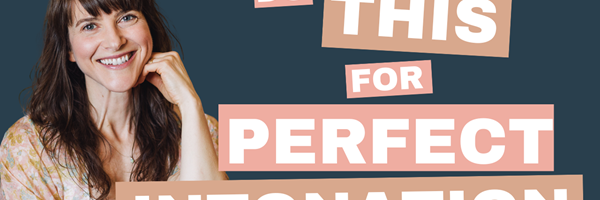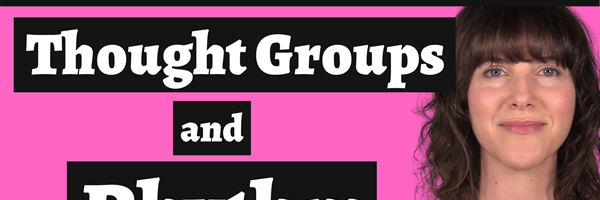(Video Transcript)
Hi, I’m Julie with San Diego Voice and Accent and in this video, you’re going to learn about advanced intonation in American English.
Intonation is such a fun topic to discuss because there are so many different ways to use intonation effectively. Your voice can go up, then down, or down then up, or maybe your voice stays on the same pitch but then goes up when you say something important.
But this is also why intonation can be challenging to learn - there are many quote “right” ways to do it, and it’s difficult to know when to use one intonation pattern over the other.
There are no absolute rules to intonation, it's up to the speaker to decide what type of intonation pattern they want to use, but there are some basic guidelines that native speakers follow. In this video, I’ll explain the basic guidelines for the intonation patterns of statements and questions, and then we'll work on the more advanced intonation patterns. To demonstrate these different types of intonation patterns, I’m going to have a conversation...with myself. I’ll be Person A on the left side of the screen, and then Person B on the right side of the screen. I’ll give you some background information about what type of intonation pattern you’re going to hear and why I use it.
American English Intonation: Statements
Let’s start with the basics of statements. Statements will typically have downward intonation at the end. This shows that you are confident about what you’ve said, and you’re finished talking. Listen to this conversation:
Person A: What’s your name?
Person B: My name’s Julie.
Person A: And where are you from?
Person B: I’m from California
Person A: And what’s your favorite type of chocolate?
Person B: I love dark chocolate.
So you heard me say a few statements about myself, and with each statement, my intonation went down at the end. I was confident about what I said, and I didn’t want to add any more information - I was done speaking. The end, period.
Now, let’s get more advanced. What if I have a longer statement...something with a few different thought groups. What then? Listen to this conversation:
A: What do you like to do for fun?
B: I really like going camping because I like being in nature and sitting by the campfire at night and roasting marshmallows.
In this conversation, I used upward or neutral intonation at the end of my thought groups. This indicated I had more to say. But at the end of my statement, I ended with downward intonation because that was the end of my answer.
There are two additional intonation patterns you could use with a statement. What if your intonation remained flat - what would that type of intonation communicate?
A: What do you like to do for fun?
B: I really like going camping because I like being in nature and sitting by the campfire at night and roasting marshmallows.
Did you believe me? Did I seem...interested in talking to you? Did I seem excited? No, I didn’t. If you use flat intonation - if your voice stays on one pitch almost the entire time - you’ll come across as sarcastic and boring. You need to do something with your intonation - go up, go down - don’t stay flat.
But what if your intonation went up at the end of a statement? What would that communicate?
A: What do you like to do for fun?
B: I really like going camping because I like being in nature and sitting by the campfire at night and roasting marshmallows.
Did I seem confident about what I was saying? Were you waiting for me to say more at the end? Did it seem like I was asking a question at the end? Upward intonation throughout a statement, and especially at the end of a statement, can make you seem unsure of yourself, or it can indicate to your listener that you have more to say. Or, it can turn that statement into a question.
Person A: What’s your name?
Person B: My name’s Julie?
Person A: And where are you from?
Person B: I’m from California?
Person A: And what’s your favorite type of chocolate?
Person B: I love dark chocolate?
American English Intonation: Yes/No Questions
By adding upward intonation to the end of the statement, I turned each statement into a question. And this type of question is called a yes/no question. The answer to the question is either yes or no.
My name’s Julie?
Yes.
I’m from California?
Yes.
I love dark chocolate?
Yes.
Now listen to this conversation. What do you think I’m trying to communicate with this type of intonation?
A: What’s your name?
B: My name’s Julie.
A: Your name’s Julie?
B: Um...yes?
A: And where are you from?
B: I’m from California.
A: You’re from California?
B: Uhh...yes?
A: And what’s your favorite type of chocolate?
B: I love dark chocolate.
A: You love dark chocolate?
B: Umm….
So how did I sound in my follow-up question? I was asking a yes/no question, so my intonation went up at the end...but it went up more abruptly, at a faster, steeper incline. This usually is interpreted as being rude or offensive.
Now, one more type of advanced intonation of yes/no questions. Listen to this conversation - what do you think my intonation is trying to communicate?
Person A: What’s your name?
Person B: My name’s Julie. My name’s Julie?!
Person A: And where are you from?
Person B: I’m from California. I’m from California?!
Person A: And what’s your favorite type of chocolate?
Person B: I love dark chocolate. I love dark chocolate?!
My intonation went up at the end, but the change in intonation was bigger, more dramatic, and the pitch of my voice went higher. My facial expressions also changed - my eyebrows went up and my eyes got bigger. This type of upward intonation plus the facial expressions indicated surprise or doubt or disbelief.
If I say: Your shoes cost $100? I’m expecting the answer to be yes or no, and I don’t anticipate I’ll be surprised by that. But..
Your shoes cost $100?!
Again, this is a yes/no question, so the answer is going to be either yes or no, but I already know the answer is yes, and I can’t believe it, or I’m shocked by that information.
American English Intonation: WH Questions
Let’s discuss another type of question, a WH question. These are questions that begin with the WH words, like “who, what, where, when, why and how”. The answer to these questions is not a yes or no. Instead, these questions require an open-ended answer. And we’ll start with the basics. Typically, WH questions have downward intonation. Listen to this conversation.
A: What time is it?
B: It’s 12 o’clock.
A: Who’s coming to dinner tonight?
B: My sister and her new boyfriend are coming over for dinner.
A: How many cats do you have?
B: I have four cats.
I used downward intonation at the end of each WH question. This indicated that I didn’t anticipate that I would be surprised by the answer, or maybe I already knew the answer and I wanted confirmation.
Now, let’s get more advanced. What if I use upward intonation at the end of a WH question? What would that communicate?
A: What time is it?
B: It’s 12 o’clock.
A: Who’s coming to dinner tonight?
B: My sister and her new boyfriend are coming over for dinner.
A: How many cats do you have?
B: I have four cats.
If you use upward intonation with a WH question, it can indicate that you’re unsure of the answer to the question and you are asking for more information, or you might be slightly surprised by the answer.
Now let’s take it one step further. Let’s say you know the answer to the question - it’s 12 o’clock - but you are very surprised by that information. You might ask the WH question again, but this time you’ll use even more intonation. Listen to these examples.
B: The time is 12 o’clock.
A: What time is it?!
B: It’s 12 o’clock.
B: We have dinner plans with my sister and her new boyfriend.
A: Who’s coming to dinner tonight?!
B: My sister and her new boyfriend are coming over for dinner.
B: I love my four cats.
A: How many cats do you have?!
B: I have four cats.
In this conversation, my intonation was bigger, more dramatic, and the pitch of my voice was higher. My facial expressions also changed - my eyebrows went up and my eyes got bigger. This indicated I was very shocked by the answer.
American English Intonation: Practice
Let’s practice both the basic and advanced intonation patterns of statements, yes/no questions, and WH questions.
I’ll say each sentence three times, and then you’ll have a chance to repeat. Don’t worry about the pronunciation; instead, I want you to imitate the intonation.
Basic Intonation: Statement (downward intonation)
Today is Monday.
Advanced Intonation: Statement (upward and downward intonation)
I had a turkey sandwich for lunch, and it was so delicious - I’m going to have it again tomorrow!
Flat Intonation: Statement (incorrect intonation)
I had a turkey sandwich for lunch, and it was so delicious - I’m going to have it again tomorrow.
Upward Intonation: Statement (statement becomes a question)
I had a turkey sandwich for lunch, and it was so delicious - I’m going to have it again tomorrow?
Basic Intonation: Yes/No Question (slight upward intonation; neutral question)
You want to go?
Do you want to go?
Advanced Intonation: Yes/No Question (abrupt upward intonation; rude/offensive question)
You want to go?
Advanced Intonation: Yes/No Question (dramatic upward intonation; surprise, doubt, or disbelief; facial expressions - eyebrows raised, eyes bigger)
You want to go?!
Basic Intonation: WH Question (downward intonation; neutral question)
What time is it?
Advanced Intonation: WH Question (slight upward intonation; unsure of answer, slight surprise, want more information)
What time is it?
Advanced Intonation: WH Question (dramatic upward intonation; very surprised or doubtful of the answer; facial expressions - eyebrows raised, eyes bigger)
What time is it?!?
I hope you enjoyed this video from San Diego Voice and Accent. Thanks for watching, and have a great day!
And I'd love to hear from you - contact me to learn how we can work together to perfect your American English pronunciation!



